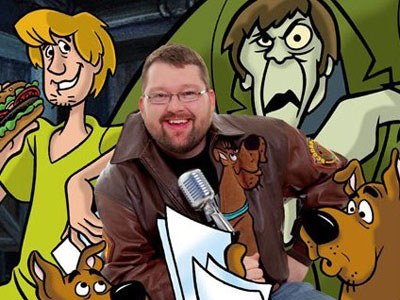For some time, Warner Brothers has had the following unofficial policy regarding the casting of voices for the classic characters they own. To the extent possible, they try to hire the originator of the voice. When that person becomes unavailable — usually, because they've died — the role is up for grabs, and various crannies of Time-Warner have cast various folks for various projects. At least eight different actors have spoken for Bugs Bunny since Mel Blanc passed away, and it has not been uncommon for one guy to be doing that Wascally Wabbit for a TV cartoon while someone else is doing him for a commercial and someone else is doing him for a videogame. To make matters more complicated, some of those actors have more than one interpretation of the same voice. One of the many performers who plays Daffy Duck has had to develop four different approaches — one based on the early, screwy Daffy; one based on the greedy Daffy of the "Duck Season/Rabbit Season" era; one more like what Mel did in the sixties, and one that more or less splits these differences to create an amalgam. "When I work for one division, they want Version A," he explains. "Another division insists that Version B is the way The Duck ought to sound, and so on."
Sources inside WB tell me that this practice is ending; that they're in the process of zeroing in on a "one character, one voice" actor policy. Until they get it perfected, the classic WB and Hanna-Barbera characters will continue to be played by a wider list of actors than has tackled Macbeth.
At least three men have provided the sounds of Scooby Doo since his original voice, Don Messick, died in 1997. The recent theatrical feature had the pooch done by an Australian actor named Neil Fanning, about whom I know nothing. The current TV series has a Scooby voiced by Frank Welker, who has also been the voice of Fred since the first Scooby Doo show in 1969. Most of the mutt's other appearances have come to us through the vocal cords of a Louisiana-based disc jockey, Scott Innes.
Scott is an amazing talent and, as I say in the foreword to his autobiography, he does an uncanny facsimile of Mr. Messick's mutterings. He has also occasionally done the voice of Shaggy when its originator, Casey Kasem, couldn't or wouldn't. (The story is that Mr. Kasem, a firm vegetarian, declined to venture near Shaggy during the time the character was appearing in commercials for Burger King. Casey is back on the new series.) Scott also did the voice of Scrappy Doo in the Scooby Doo feature, deftly bridging the gap between Scrappy's two voices (by Lennie Weinrib and then Messick). Most of the time, being in another state would disqualify a voice actor from working for the Hollywood studios, but Innes is that good.

Anyway, this is a plug for that autobiography. It's a slim, easy-to-read volume, profusely illustrated, that will answer many of the basic questions about what it's like to be a voice actor (and a disc jockey). At the moment, it's available only at www.scottinnes.com, but that's okay because if you buy it there, Scott will autograph your copy. And while you're there, browse around, look at the pictures, even listen to some clips from his radio show. I like Scott, if for no other reason than that he restores my faith in America. It's a great country where any young man can grow up to be a Great Dane…